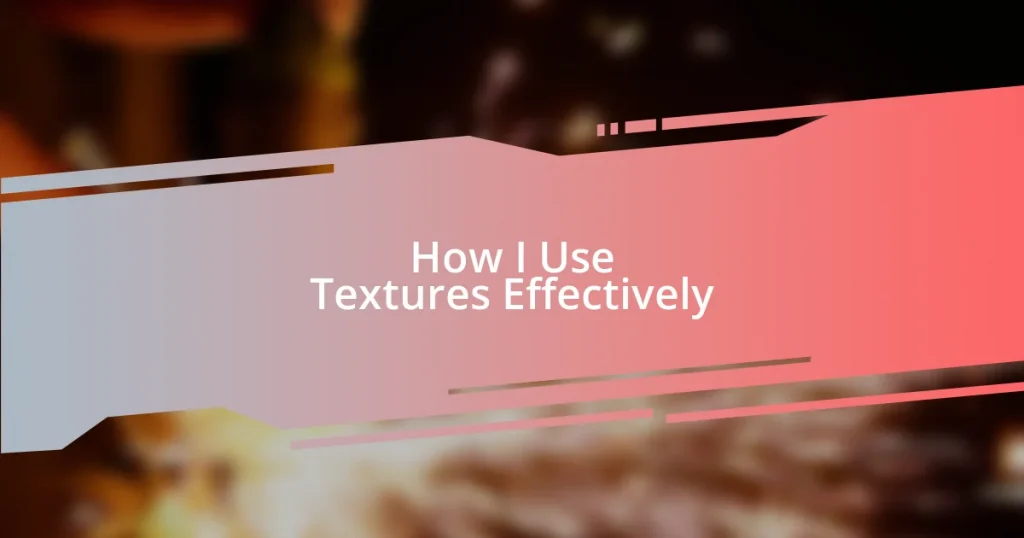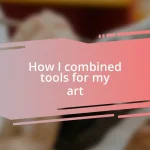Key takeaways:
- Textures significantly affect emotions and perceptions, with physical and visual textures serving different purposes in design.
- Effective layering and thoughtful consideration of scale and context are crucial for creating engaging and harmonious designs.
- Common mistakes include overloading designs with too many textures and failing to align texture choices with the target audience’s identity.
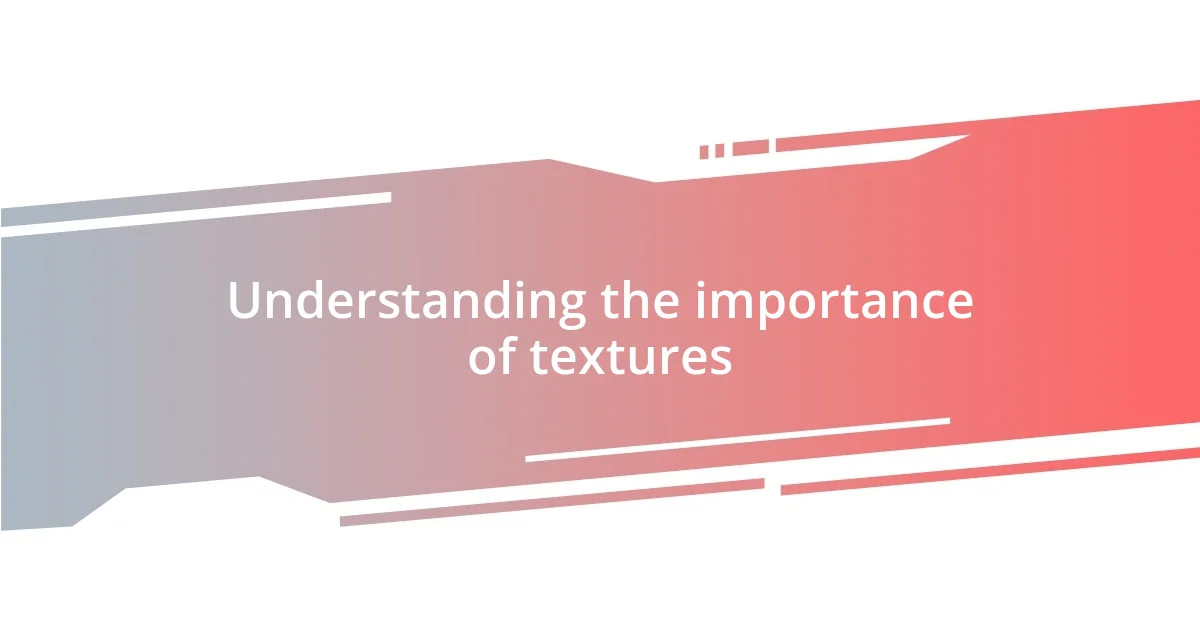
Understanding the importance of textures
Textures can dramatically transform a visual experience. I remember attending an art exhibit where the curator expertly layered various materials. Each texture invoked different feelings and drew me deeper into the narrative, making me wonder: how much can a simple texture influence our emotions?
When I work on my projects, I often think about how a rough surface can evoke strength, while smoothness can suggest calm or sophistication. One time, I used velvet in a design, and the softness not only caught the eye but also invited viewers to reach out and touch. It was fascinating to see how an unexpected choice could create such a strong connection.
Even in everyday life, textures shape our perceptions and interactions. I find myself more drawn to fabrics that feel inviting and cozy, such as wool or cotton. They make me smile just by their touch, don’t you think? Understanding this influence helps me choose textures that resonate on a personal level, ultimately enhancing the emotional depth of my work.
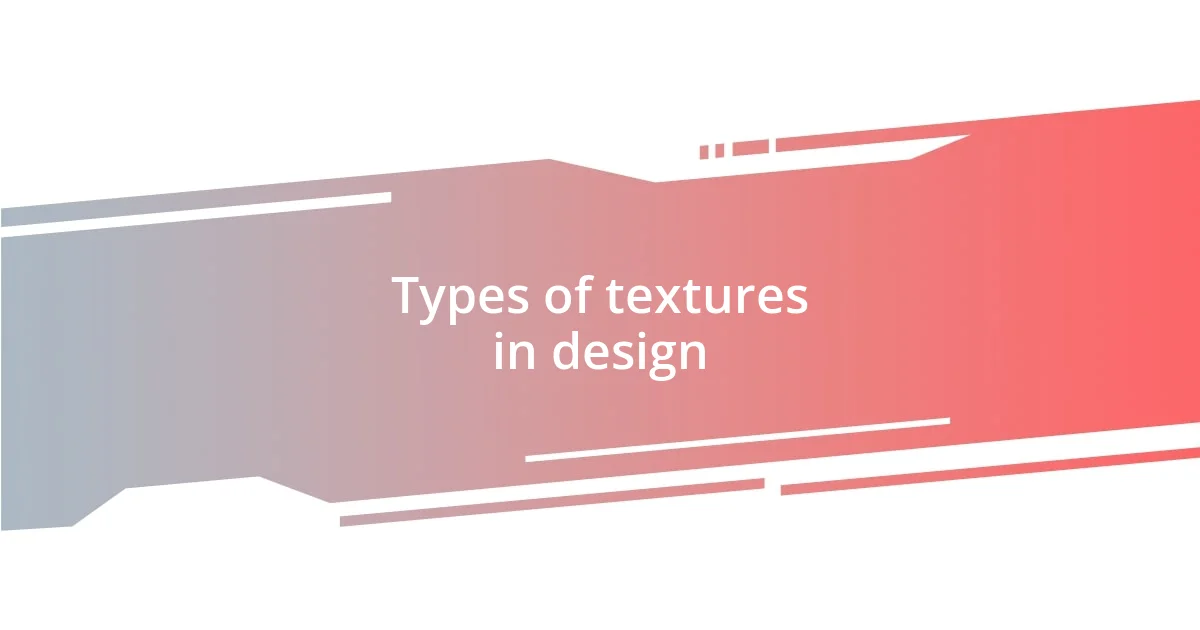
Types of textures in design
Textures come in various forms, each playing a crucial role in design. For instance, I often differentiate between physical textures and visual textures. Physical textures, like wood or fabric, invite a tactile response, while visual textures, such as patterns or colors, create an illusion of depth. I recall a project where I combined both types; wood grain digitally printed on a flat surface created a striking contrast that captivated viewers.
When I design, I also consider organic versus geometric textures. Organic textures resemble natural forms, evoking feelings of comfort or earthiness. In contrast, geometric textures tend to provide a more structured and polished look. I remember using a mix of both in a branding project—crisp lines paired with softer, flowing elements—allowing the brand’s personality to shine through. It was exciting to witness how these choices affected the audience’s perception.
In my experience, the context of texture matters just as much as the textures themselves. For example, integrating a coarse texture in a corporate layout can strike the wrong chord, while a smooth, sleek finish might elevate the message of professionalism. I once experimented with this in an online portfolio, where I used a contrasting texture for the background to highlight my projects. The balance created an engaging visual hierarchy that kept visitors interested.
| Type | Description |
|---|---|
| Physical Textures | Tactile surfaces that stimulate touch, such as fabric and wood. |
| Visual Textures | Patterns or colors that provide depth in visual design without physical dimension. |
| Organic Textures | Natural forms that evoke comfort and familiarity. |
| Geometric Textures | Structured and orderly patterns that convey a modern and polished aesthetic. |
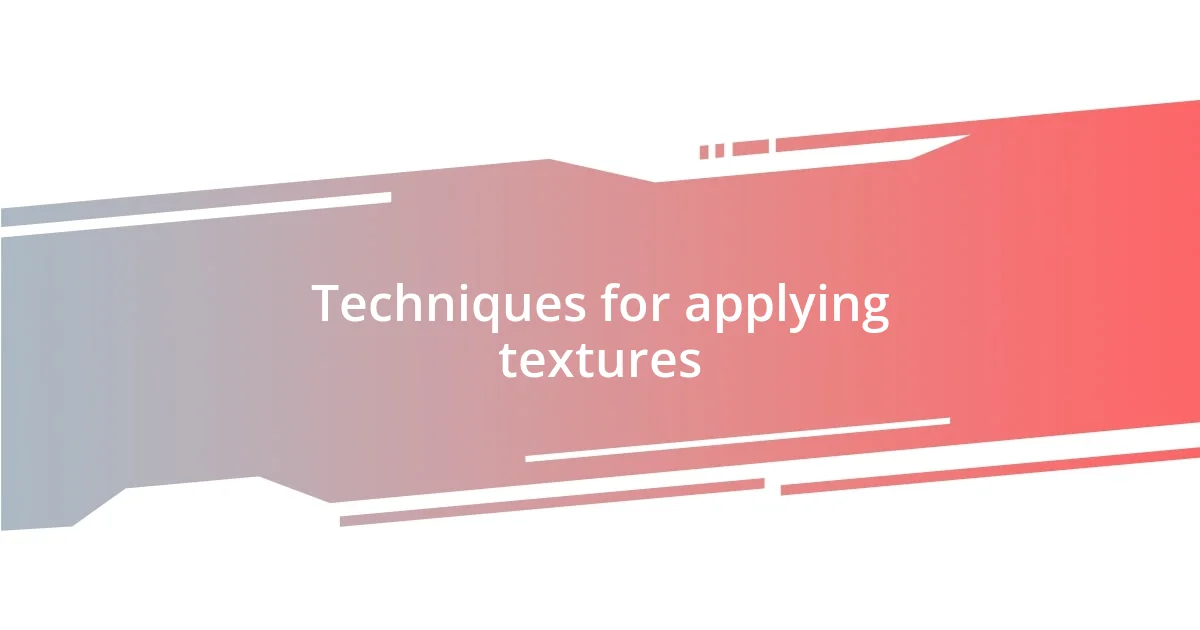
Techniques for applying textures
When it comes to applying textures effectively, I often turn to layering techniques. By overlapping different textures, I can create a rich tapestry that adds depth and interest. I recall a project where I used translucent fabrics over printed materials, allowing the colors beneath to slightly peek through. This added a dreamy quality that resonated with viewers, making them linger over the piece longer than I anticipated.
Here are some techniques that have shaped my approach:
- Layering: Combine multiple textures to create complexity and depth.
- Contrasting: Use smooth textures against rough surfaces to highlight differences and draw attention.
- Highlighting Details: Employ close-up perspectives of textures to emphasize their uniqueness and appeal.
- Monochromatic Schemes: Stick to a single color palette with varying textures to maintain cohesion while introducing tactile variety.
- Incorporating Negative Space: Utilize empty areas around textures to enhance their presence and impact.
Another technique I swear by is scale variation. Playing with different scale sizes can significantly alter the visual impact of textures. For instance, I once showcased oversized woven baskets alongside smaller, finer textures in an art installation. The juxtaposition created a dynamic visual interest that drew viewers in. People found themselves curious about the details in the smaller textures, all the while appreciating the presence of the larger pieces. It’s incredible how scale can shift our perception and engagement with textures.
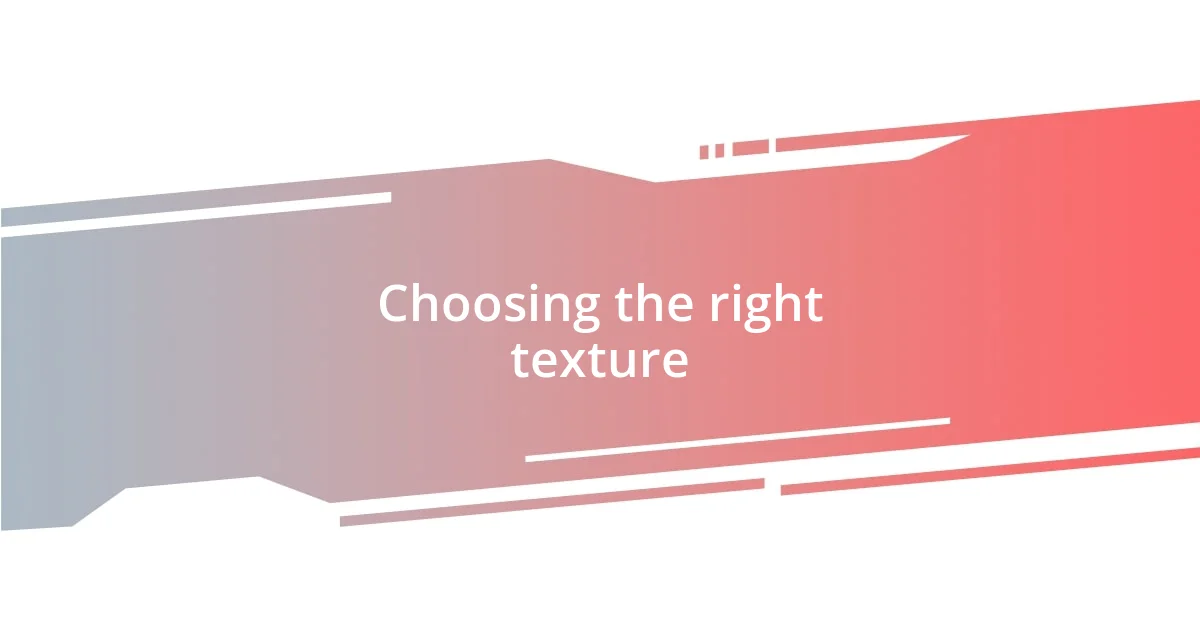
Choosing the right texture
Choosing the right texture can truly transform a design. I like to start by considering the emotions I want to evoke—does it need to feel cozy and inviting, or sleek and professional? I once chose a soft linen texture for a friend’s wedding invitation, which perfectly captured the romantic vibe they aimed for. It made me realize how much texture can enhance the overall narrative of a piece.
I also believe that pairing textures thoughtfully can create stunning results. In one graphic project, I experimented with a rough burlap background against smooth, elegant typography. The contrast was striking, and it brought out the text beautifully, almost as if the texture was giving the words a voice of their own. It made me wonder how often we overlook the power of such combinations in our designs.
When selecting textures, I often think about the context in which they’ll be used. One time, I used a sleek metallic texture for an electronic product’s ad, wanting to convey modernity and innovation. The response was overwhelming! People were drawn to it, and they could almost feel the cutting-edge technology through the visual. That experience solidified my belief that right texture choice is key. It’s about finding that connection between your audience and the message you want to deliver. Don’t you think that’s something worth pondering?
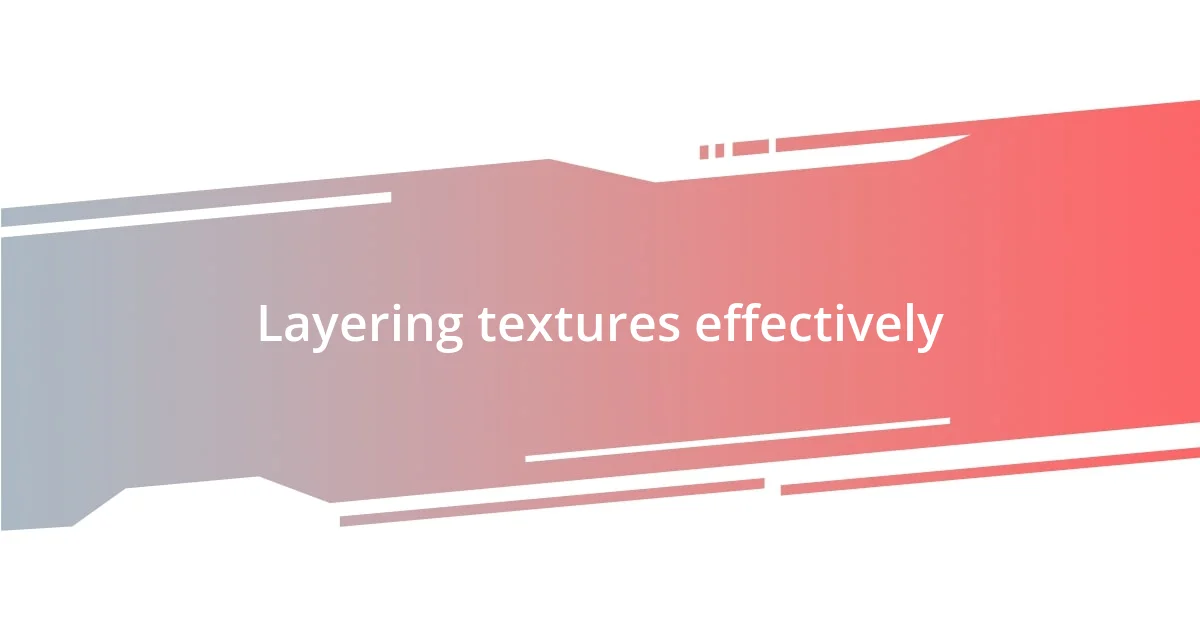
Layering textures effectively
Layering textures effectively requires a delicate balance and a keen eye for detail. I remember one time when I created a mixed-media piece that featured rich velvet layered over a canvas with intricate paint strokes. The combination not only added depth but also created a sensory experience that invited viewers to engage more closely with the work. It reminded me how important the layering of textures can be in evoking emotions; sometimes, the simplest layers can convey the deepest feelings.
There’s a certain thrill in experimenting with unexpected combinations. For instance, I once paired a soft, fuzzy wool with sleek, cold metal accents in a home decor project. The contrast felt both daring and inviting, capturing attention instantly. Every time I look at that space, I’m reminded of how the right textures can create a conversation—one that invites people to touch, feel, and truly experience the environment. Have you ever felt a texture that instantly transported you somewhere else? That’s the kind of magic I strive for when layering textures.
It’s essential to consider how each layer interacts with the others. I often find that the top texture should play off the underlying ones; for example, a light lace overlay can soften a bold-patterned fabric underneath, creating a harmonious blend. When I achieved this in a fashion design project, the final look felt effortlessly chic, as if each layer was meant to compliment the others rather than compete. It makes me think—what stories can your textures tell when they work together? Exploring that interaction can lead to some beautifully unexpected results.
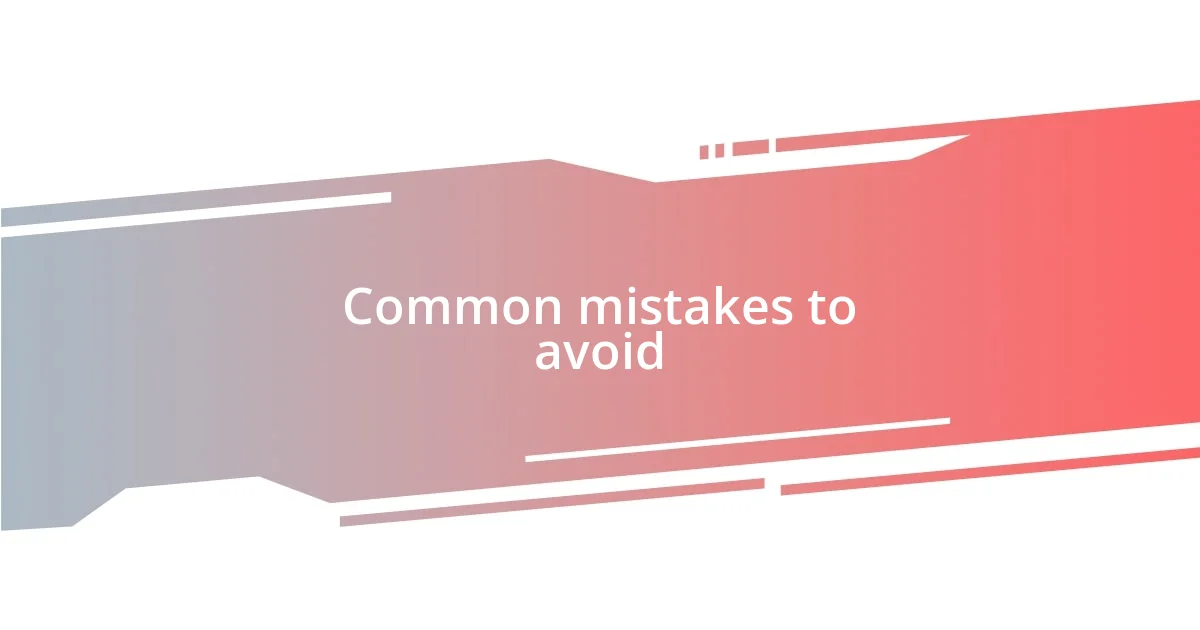
Common mistakes to avoid
One common mistake I’ve noticed is overloading a design with too many textures at once. I once attempted to incorporate five different textures in a single piece, thinking it would create a vibrant explosion of interest. Instead, it became chaotic and overwhelming; I lost the focus entirely. Can you imagine how the viewer felt? Sometimes, less is more, and it’s crucial to allow each texture to breathe.
Another pitfall is failing to consider the scale of textures. In a project where I used a large, bold granite texture on a small business card, it ended up dwarfing the information I wanted to showcase. The card felt clunky, and I was left wishing I had chosen something subtler to let the text shine. Have you ever found yourself lost in a design because the elements just didn’t fit together right? It’s a learning experience that highlights the importance of scale and proportion.
Don’t overlook the context where your texture will appear. I remember a campaign where I chose a rugged, outdoor texture for a product aimed at urban professionals. While I thought it added an adventurous vibe, feedback revealed that it felt misaligned with the audience’s everyday aesthetic. This taught me a vital lesson: always ensure that the textures resonate with the target demographic. How does your choice of texture mirror or contrast the identity of your audience? It’s a question worth contemplating as you design.
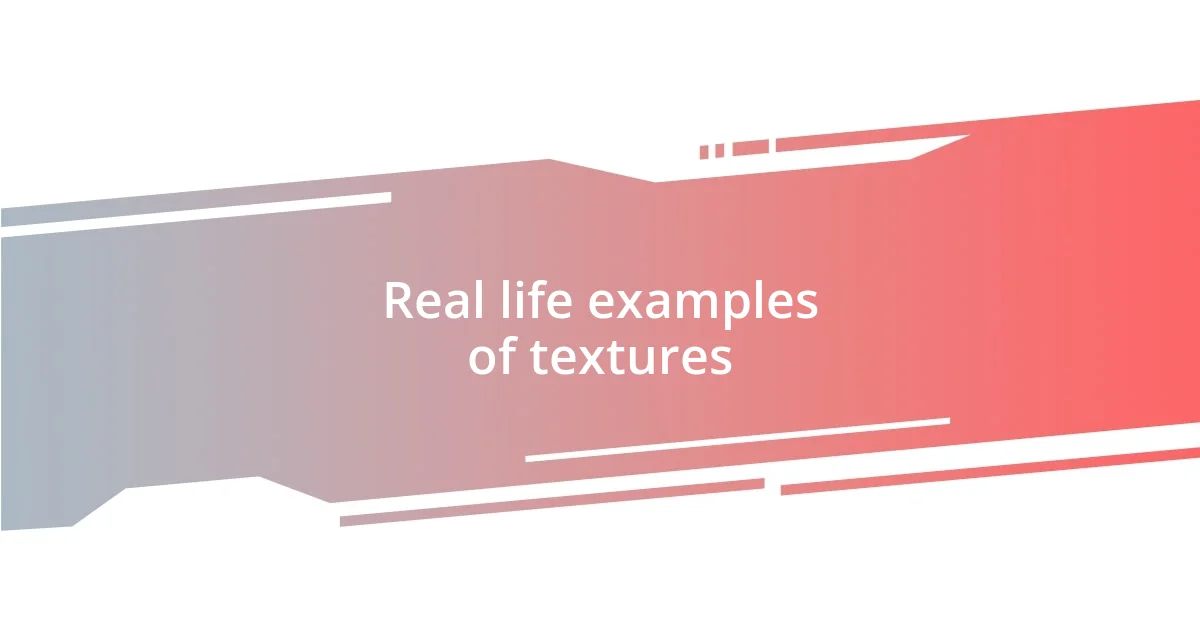
Real life examples of textures
I’ve always been captivated by the way textures can transform everyday experiences. One time, while walking through a local artisan market, I stumbled upon a handmade ceramic vase with a rough, tactile surface. It was unlike anything else, and I couldn’t resist running my fingers over it. That moment solidified my appreciation for how a texture can evoke a sense of belonging and connection to the artist’s intention. Have you ever touched something that made you feel an immediate bond to the creator?
Another vivid example comes from my travels in Italy. I encountered a rustic cobblestone street, contrasting beautifully with the smooth, cool marble of nearby sculptures. The juxtaposition was striking; each texture told a story of its own history and purpose. Isn’t it fascinating how the surroundings can shift your perspective? I often find myself pondering how to recreate that feeling in my own designs—how to merge elements from different environments to create a narrative.
I also recall a moment in my kitchen when I decided to incorporate various textures in a simple meal. By arranging a plate with crispy golden roasted vegetables alongside creamy, velvety puree, I aimed to elevate the dining experience. The visual and tactile contrast not only made the meal more appealing but also sparked conversations about the harmony in diversity. Have you experimented with textures in your own cooking or presentations? If you haven’t yet, it’s an exciting avenue worth exploring!










